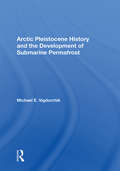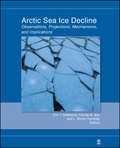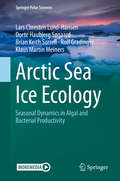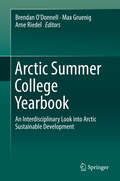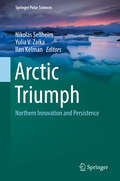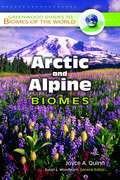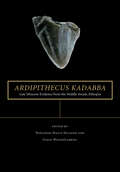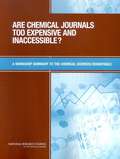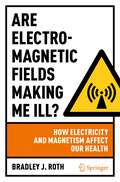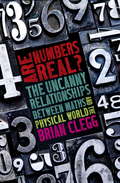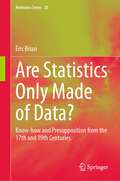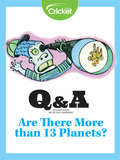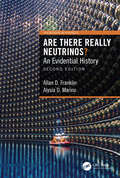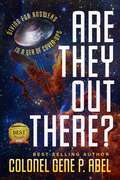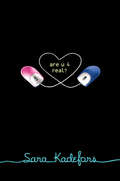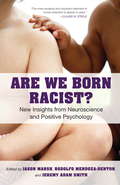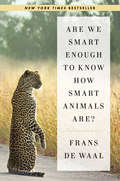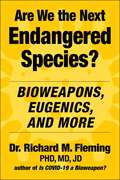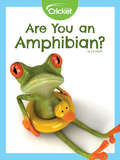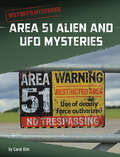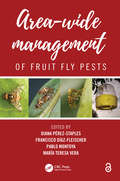- Table View
- List View
Arctic Pleistocene History And The Development Of Submarine Permafrost
by Michael E. VigdorchikThe regional distribution, composition, structures, thermal state and regime, thermophysical characteristics, and dynamics of temperature changes of submarine permafrost are considered, based on Eurasiatic shelf data. The origin and development of permafrost is closely connected with the specifics of Arctic Basin development during the Pleistocene
Arctic Sea Ice Decline: Observations, Projections, Mechanisms, and Implications
by Cecilia M. Bitz L. Bruno Tremblay Eric T. DeweaverPublished by the American Geophysical Union as part of the Geophysical Monograph Series, Volume 180.This volume addresses the rapid decline of Arctic sea ice, placing recent sea ice decline in the context of past observations, climate model simulations and projections, and simple models of the climate sensitivity of sea ice. Highlights of the work presented here includeAn appraisal of the role played by wind forcing in driving the decline;A reconstruction of Arctic sea ice conditions prior to human observations, based on proxy data from sediments;A modeling approach for assessing the impact of sea ice decline on polar bears, used as input to the U.S. Fish and Wildlife Service's decision to list the polar bear as a threatened species under the Endangered Species Act;Contrasting studies on the existence of a "tipping point," beyond which Arctic sea ice decline will become (or has already become) irreversible, including an examination of the role of the small ice cap instability in global warming simulations;A significant summertime atmospheric response to sea ice reduction in an atmospheric general circulation model, suggesting a positive feedback and the potential for short-term climate prediction.The book will be of interest to researchers attempting to understand the recent behavior of Arctic sea ice, model projections of future sea ice loss, and the consequences of sea ice loss for the natural and human systems of the Arctic.
Arctic Sea Ice Ecology: Seasonal Dynamics in Algal and Bacterial Productivity (Springer Polar Sciences)
by Lars Chresten Lund-Hansen Dorte Haubjerg Søgaard Brian Keith Sorrell Rolf Gradinger Klaus Martin MeinersThe book on sea ice ecology is the ecology of sea ice algae and other microorganism as bacteria, meiofauna, and viruses residing inside or at the bottom of the sea ice, called the sympagic biota. Organisms as seals, fish, birds, and Polar bears relies on sea ice but are not part of this biota. A distinct feature of this ecosystem, is the disappearance (melt) every summer and re-establishing in autumn and winter. The book is organized seasonally describing the physical, optical, biological, and geochemical conditions typical of the seasons: autumn, winter, and spring. These are exemplified with case studies based on author’s fieldwork in Greenland, the Arctic Ocean, and Antarctica but focused on Arctic conditions. The sea ice ecosystem is described in the context of climate change, interests, and effects of a decreasing summer ice extent in the Arctic Ocean. The book contains an up to date description of most relevant methods and techniques applied in sea ice ecology research.This book will appeal to university students at Masters or PhD levels reading biology, geosciences, and chemistry.
Arctic Summer College Yearbook: An Interdisciplinary Look into Arctic Sustainable Development
by Brendan O'Donnell Max Gruenig Arne RiedelThis book highlights both the diversity of perspectives and approaches to Arctic research and the inherent interdisciplinary nature of studying and understanding this incomparable region. The chapters are divided into four liberally-defined sections to provide space for dynamic interpretation and dialogue in search of sustainable solutions to the issues facing the Arctic. From governance to technology, scientific research to social systems, human health to economic development, the authors discuss fundamental questions while looking toward the Arctic's future. Whether the reader is well-versed in the history and complexity of Arctic policy or looking for an insightful introduction to the vast world of Arctic research, everyone will find answers that lead to new questions and even more discoveries in these pages, laying the foundation for tomorrow's discussion on the future of the Arctic. The Arctic's unique geographic and political characteristics pose questions for the international community, indigenous peoples, and economic interests not easily answered through traditional concepts. To that end, the Arctic Summer College has been engaging leading professionals, students, scholars, and policy makers from across the globe to exchange ideas and support further investigation into the Arctic. A joint venture between Ecologic Institute US and Ecologic Institute Berlin (Germany), the College participates at the annual Arctic Circle Assembly in Reykjavik, Iceland, and continues to be at the forefront of international collaboration in this critical area of economic, political, environmental, and humanitarian development.
Arctic Triumph: Northern Innovation and Persistence (Springer Polar Sciences)
by Ilan Kelman Nikolas Sellheim Yulia V. ZaikaThis book approaches the challenges the Arctic has faced and is facing through a lens of opportunity. Through pinpointed examples from and dealing with the Circumpolar North, the Arctic is depicted as a region where people and peoples have managed to endure despite significant challenges at hand. This book treats the ‘Arctic of disasters’ as an innovated narrative and asks how the ‘disaster pieces’ of Arctic discourse interact with the ability of Arctic peoples, communities and regions to counter disaster, adversity, and doom. While not neglecting the scientifically established challenges associated with climate change and other (potentially) disastrous processes in the north, this book calls for a paradigm shift from perceiving the ‘Arctic of disasters’ to an ‘Arctic of triumph’. Particular attention is therefore given to selected Arctic achievements that underline ‘triumphant’ developments in the north, even when Arctic triumph and disaster intersect.
Arctic and Alpine Biomes (Greenwood Guides to Biomes of the World)
by Joyce A. QuinnThe latest entry in the Guides to Biomes of the World series from Greenwood Press focuses on arctic and alpine climate zones, also known as the tundra, and provides a detailed study of the hardiest flora and fauna on the planet. Quinn (California State U., Fresno) offers straightforward descriptions of each of these biomes, dividing the information between arctic, Antarctic, alpine and even tropical alpine biomes such as the Andes and the highest zones of Hawaiian volcanoes. Written primarily as a textbook for geography students, this book also features vivid color photographs from these regions.
Arcturian Songs Of The Masters Of Light: Arcturian Star Chronicles, Volume Four (The Arcturian Star Chronicles)
by Patricia PereiraIn 1987, medical transcriptionist Patricia Pereira suddenly started receiving telepathic communications from the star Arcturus and was requested to begin a series of galactically inspired manuscripts, Arcturian Songs of the Masters of Light is the fourth volume in the series. The mission of this series of books is to awaken us to our individual and collective spiritual obligation for the health and well being of our planet and all creatures who live upon her. Philosophical in cope, the essays in these books provide pragmatic, practical suggestions for emotional, mental physical, and spiritual transformation. They remind us of our familial relationships to beings of light who inhabit the great star nations. Arcturian Songs of the Masters of Light moves beyond solely Arcturian energies to incorporate high-level representatives of the brotherhoods of light, including Christ Essence and Sanat Kumara of the Order of Melchizedek.
Ardipithecus kadabba: Late Miocene Evidence from the Middle Awash, Ethiopia (The Middle Awash Series)
by Yohannes Haile-Selassie Giday WoldegabrielThe second volume in a series dedicated to fossil discoveries made in the Afar region of Ethiopia, this work contains the definitive description of the geological context and paleoenvironment of the early hominid Ardipithecus kadabba. This research by an international team describes Middle Awash late Miocene faunal assemblages recovered from sediments firmly dated to between 5.2 and 5.8 million years ago. Compared to other assemblages of similar age, the Middle Awash record is unparalleled in taxonomic diversity, composed of 2,760 specimens representing at least sixty five mammalian genera. This comprehensive evaluation of the vertebrates from the end of the Miocene in Africa provides detailed morphological and taxonomic descriptions of dozens of taxa, including species new to science. It also incorporates results from analyses of paleoenvironment, paleobiogeography, biochronology, and faunal turnover around the Pliocene-Miocene boundary, opening a new window on the evolution of mammals, African fauna, and its environments.
Are Chemical Journals Too Expensive And Inaccessible?: A Workshop Summary To The Chemical Sciences Roundtable
by National Research Council of the National AcademiesOn October 25-26, 2005, the Chemical Sciences Roundtable held a workshop to explore issues involving those who use and contribute to chemical literature, as well as those who publish and disseminate chemical journals. As a follow-up to the workshop, a summary was written to capture the presentations and discussions that occurred during the workshop. As a forum to discuss chemistry journals within the larger context of scientific, technical and medical journal publishing, the workshop covered whether chemists and chemical engineers have unique journal needs and, if so, whether these needs are being met in the current journal publishing environment. Workshop participants also tackled how open access publishing might be applied to the chemical literature, such as to provide authors more freedom to distribute their articles after publication and allowing free access to chemical literature archives.
Are Electromagnetic Fields Making Me Ill?: How Electricity and Magnetism Affect Our Health
by Bradley J. RothElectricity and Magnetism (E&M) underlies many lifesaving medical devices, such as magnetic resonance imaging scanners, neural stimulators, and heart pacemakers. But E&M also attracts its share of bogus health claims, such as biomagnetic therapy. How do you separate the good from the bad? Sometimes it’s not easy: experiments are prone to artifacts, theories are limited by assumptions, and clinical trials can result in ambiguities. In this book, the author separates the wheat from the chaff, showing which applications of E&M are bogus and which are not. This book takes the reader on a tour through a range of fascinating phenomena, from effects that are constant in time at one extreme, such as transcranial direct current stimulation of the brain, to the millimeter-wave whole-body scanners which are familiar to frequent flyers at the other. Along the way, the author looks in depth at the dispute about power line magnetic fields and leukemia, a case study in what can go wrong when dubious claims inflame unjustified fears. The debate about cell phones and brain cancer still rages today, particularly for the microwave frequencies encountered with new 5G technology. Recently, the so-called Havana Syndrome has been attributed to microwave weapons, but the underlying biophysics of such weapons is unclear. For all these encounters with electricity and magnetism, the author, an eminent biophysicist, uses science and evidence to sort out fact from fantasy. This book is aimed at general readers who want to make sense of the mysterious and often controversial ways in which E&M interacts with the human body. It is also ideal for students and professionals in bioscience and health-related fields who want to learn more without getting overwhelmed by theory.
Are Numbers Real?: The Uncanny Relationships Between Maths and the Physical World
by Brian CleggHave you ever wondered what humans did before numbers existed? How they organized their lives, traded goods, or kept track of their treasures? What would your life be like without them? Numbers began as simple representations of everyday things, but mathematics rapidly took on a life of its own, occupying a parallel virtual world. In Are Numbers Real? Brian Clegg explores the way that maths has become more and more detached from reality, yet despite this is driving the development of modern physics. From devising a new counting system based on goats, through the weird and wonderful mathematics of imaginary numbers and infinity to the debate over whether mathematics has too much influence on the direction of science, this fascinating and accessible book opens the reader's eyes to the hidden reality of the strange yet familiar world of numbers.
Are Statistics Only Made of Data?: Know-how and Presupposition from the 17th and 19th Centuries (Methodos Series #20)
by Éric BrianThis book examines several epistemological regimes in studies of numerical data over the last four centuries. It distinguishes these regimes and mobilises questions present in the philosophy of science, sociology and historical works throughout the 20th century. Attention is given to the skills of scholars and their methods, their assumptions, and the socio-historical conditions that made calculations and their interpretations possible. In doing so, questions posed as early as Émile Durkheim’s and Ernst Cassirer’s ones are revisited and the concept of symbolic form is put to the test in this particular survey, conducted over long period of time. Although distinct from a methodological and epistemological point of view, today these regimes may be found together in the toolbox of statisticians and those who comment on their conclusions. As such, the book is addressed to social scientists and historians and all those who are interested in numerical productions.
Are There More than 13 Planets?
by Lizzie WadeAre there more than 13 planets in our solar system? Learn how astronomers catagorize the objects out in space.
Are There Really Neutrinos?: An Evidential History
by Allan FranklinIn this intriguing and accessible book, physicist Allan Franklin examines the experiments on neutrino oscillations. He argues that this history gives us good reason to believe in the existence of the neutrino, a particle that interacts so weakly with matter that its interaction length is measured in light years of lead. Only recently, the scientific process has provided evidence of the elusive neutrino. Written in a style accessible to any reader with a college education in physics, Are There Really Neutrinos? is of interest to students and researchers alike.
Are There Really Neutrinos?: An Evidential History (Frontiers in Physics)
by Allan D. Franklin Alysia D. MarinoThis intriguing and accessible book examines the experiments on neutrino oscillations. It argues that this history gives us good reason to believe in the existence of neutrinos, a particle that interacts so weakly with matter that its interaction length is measured in light years of lead. Yet, the scientific process has provided evidence of the elusive neutrino. Written in a style accessible to any reader with a college education in physics, Are There Really Neutrinos? is of interest to students and researchers alike. This second edition contains a new epilogue highlighting the new developments in neutrino physics over the past 20 years.
Are They Out There?: Diving for Answers In a Sea of Cover-Ups
by Gene P. Abel&“If you're ready to read a realistic approach to the possibility of alien life and whether we are visited by them, you will love Are They Out There? Diving for Answers In a Sea of Cover-Ups.&” – Readers&’ FavoriteNothing in the universe is unique and alone, and therefore in other regions there must be other earths inhabited by different tribes of men and different breeds of beast. - Titus Lucretius, De Rerum Natura circa 50BCE The question, Are They Out There? is not a new one. Since ancient times, humans have wondered about the potential of alien life. Between May 1, 2023, and June 1, 2024, alone, sightings of more than seven hundred unidentified aerial phenomena were reported-and twenty-one of these cases are still under investigation. They can't be explained by common objects. In Are They Out There? retired Colonel Gene P. Abel sifts through the accounts of military professionals and eyewitnesses alike in search of the truth about extra-terrestrial visitors. Discover what Colonel Abel has uncovered, and what the government might not be telling us, in this gripping new look at the history, and potential future impact, of UFOs, and alien contact. A newly released US report on unidentified flying objects says 143 sightings since 2004 remain unexplained. It does not rule out alien activity. - The New York Times, June 25, 2021
Are U 4 Real?
by Sara KadeforsKyla is exactly the kind of girl Alex could never talk to in real life. She's a gorgeous, outspoken L. A. girl who parties to forget about her absent father and depressed mother. He's a shy ballet dancer from outside San Francisco who's never been kissed. Luckily, when these sixteen-year-olds meet for the first time it's not in real life-it's in a chat room, where they can share their feelings of isolation and frustration away from the conformity-obsessed high school scene. Alex and Kyla quickly forge a friendship that's far from virtual- maybe they're even falling in love. But what happens when the soul mate you've never met moves from online to in person? Sara Kadefors's wildly romantic, award-winning Swedish bestseller perfectly captures the universal angst of being a teenager, and the perhaps even more universal struggle to negotiate identity in a multi-platform world.
Are We Being Watched?: The Search for Life in the Cosmos
by Paul MurdinAn engaging exploration with renowned astronomer Paul Murdin of how life emerged on Earth--and the possibilities that it exists elsewhere There is no more fascinating question than whether or not we are alone in a vast universe. Here, Paul Murdin applies the latest scientific discoveries and theories to inquire whether life exists on other planets and, if so, what forms it might take. Could there be somewhere life as advanced as here on Earth, or are we more likely to find primitive life-forms? Or are we the sole living organisms in a desolate and boundless cosmos? Professor Murdin invites us to join him in exploring an extraordinary array of evidence to determine if there is life elsewhere in the cosmos. He examines the case for life on Mars and Europa and asks whether on Enceladus or Titan we might find the "warm little" pond that Darwin speculated was where life began here on Earth. Describing the cosmic habitats that produce the alien worlds of our solar system and others, he examines the chances of finding life and the prospects for successful communication with an extraterrestrial intelligence.
Are We Born Racist?
by Jeremy A. Smith Jason Marsh Rodolfo Mendoza-DentonWhere do our prejudices come from? Why are some people more biased than others? Is it possible for individuals, and society as a whole, to truly defeat prejudice? In these pages, leading scientists, psychologists, educators, activists, and many others offer answers, drawing from new scientific discoveries that shed light on why and how our brains form prejudices, how racism hurts our health, steps we can take to mitigate prejudiced instincts, and what a post-prejudice society might actually look like. Bringing a diverse range of disciplines into conversation for the first time, Are We Born Racist? offers a straightforward overview of the new science of prejudice, and showcases the abundant practical, research-based steps that can be taken in all areas of our lives to overcome prejudice.
Are We Smart Enough to Know How Smart Animals Are?
by Frans de WaalA New York Times bestseller: "A passionate and convincing case for the sophistication of nonhuman minds." —Alison Gopnik, The Atlantic Hailed as a classic, Are We Smart Enough to Know How Smart Animals Are? explores the oddities and complexities of animal cognition—in crows, dolphins, parrots, sheep, wasps, bats, chimpanzees, and bonobos—to reveal how smart animals really are, and how we’ve underestimated their abilities for too long. Did you know that octopuses use coconut shells as tools, that elephants classify humans by gender and language, and that there is a young male chimpanzee at Kyoto University whose flash memory puts that of humans to shame? Fascinating, entertaining, and deeply informed, de Waal’s landmark work will convince you to rethink everything you thought you knew about animal—and human—intelligence.
Are We the Next Endangered Species?: Bioweapons, Eugenics, and More
by Dr. Richard M. FlemingAre We the Next Endangered Species? unravels the complex web of historical events, misinformation, and the ominous convergence of bioweapons and eugenics In this thought-provoking new book, Dr. Fleming challenges us to navigate the murky waters of history, exposing parallel programs developed over the last 170 years in the United States. This riveting exploration unearths ancient civilizations that embraced slavery, sterilization, and eugenics, drawing chilling parallels to our present reality. Dr. Fleming confronts the uncomfortable truth: are we repeating the mistakes of the past while expecting different outcomes? Are we destined to replicate the errors that led to the rise of powerful individuals and organizations seeking ultimate control over others? Key revelations include the stealthy usurpation of power in the United States since the 1850s, the nation's pivotal role in developing biological and chemical weapons, and its shocking collaboration with Nazi scientists, doctors, and intelligence officers. Dr. Fleming unveils the shadowy world of covert operations, the establishment of the military-industrial complex, and the surrender of medical control to the federal government. Readers will discover the intricate pathways of biowarfare and eugenics converging with the emergence of COVID. They will learn about the gain-of-function bioweapons responsible for the pandemic and the parallel development of eugenic genetic vaccines. Fleming reveals the control wielded by the military-industrial complex and world leaders over your life, movement, property, and freedoms. This book is not just an exploration of the past or a revelation of how those in power are on the brink of realizing their ultimate control, it's a call to action. It doesn't just raise awareness—it empowers readers to understand, question, and take decisive action to halt the ominous path we're on. In a world where truth is elusive and power is coveted, this book is a beacon of knowledge, urging you to discover what you can do to stop the impending threats to our existence. The future hangs in the balance and Are We the Next Endangered Species? provides the roadmap to safeguard it.
Are You an Amphibian?
by Liz HuyckFrogs and toads and newts, oh my! Amphibians are a special class of animals. Have you ever seen one? Learn what sets amphibians apart from reptiles, and then take a quiz to see if the animal of your choice makes the cut as an amphibian!
Area 51 Alien and UFO Mysteries (History's Mysteries)
by Carol KimA highly secure military base sits in the middle of the Nevada Desert. What happens inside is kept top secret. Many UFO sightings have been reported nearby. Some people even say alien bodies are stored there. What really goes on behind its highly guarded fences? Explore the theories and learn why Area 51 has become one of history’s greatest mysteries.
Area-Wide Management of Fruit Fly Pests
by Pablo Montoya Diana Perez-Staples Francisco Diaz-Fleischer Maria Teresa VeraFruit fly (Diptera: Tephritidae) pests have a profound impact on horticultural production and economy of many countries. It is fundamental to understand their biology and evaluate methods for their suppression, containment, or eradication. Area-Wide Management of Fruit Fly Pests comprises contributions from scientists from around the world on several species of tephritids working on diverse subjects with a focus on area-wide management of these pests. The first three sections of the book explore aspects of the biology, ecology, physiology, behavior, taxonomy, and morphology of fruit flies. The next two sections provide evidence on the efficacy of attractants, risk assessment, quarantine, and post-harvest control methods. The fifth and sixth sections examine biological control methods such as the Sterile Insect Technique and the use of natural enemies of fruit flies. The seventh section focuses on area-wide integrated pest management and action programs. Finally, the eighth section examines social, economic, and policy issues of action programs aimed at involving the wider community in the control of these pests and facilitate the development of control programs. Features: Presents information on the biology of tephritid flies. Provides knowledge on the use of natural enemies of fruit flies for their biological control. Includes research results on models and diets used for the Sterile Insect Technique. Reports developments on the chemical ecology of fruit flies that contribute to make control methods more specific and efficient. Reviews subjects such as Holistic Pest Management and Area-Wide Management Programs including social, economic, and policy issues in various countries.
